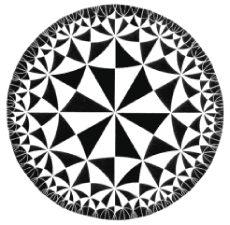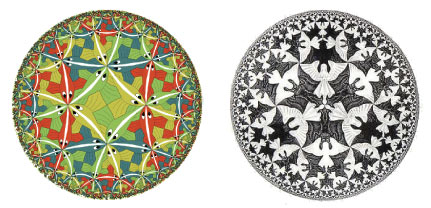 |
|
|||
|
Hyperbolic Space online exhibit - Introduction Model galleries Press and other resources |
Hyperbolic
Space |
|||
| It is one thing to know that something is possible, it is quite another to understand what it is. Like the blind man and the elephant, hyperbolic space appears in different guises depending on how we approach it. One way of visualizing this enigmatic space was discovered by the great French mathematician Henri Poincaré. In the Poincaré disc model the entire hyperbolic space is depicted inside a circle. |
||||
 |
||||
| Poincaré Disc Model | ||||
In reality, hyperbolic space is infinitely large. Like the Euclidean plane it goes on forever. But in order for us to depict it within our Euclidean framework we have to make some compromises. The Poincaré compromise is to represent angles truly while distorting scale. In this diagram all the sides of all the triangular shaped areas are, in fact, of equal length. In his book Science and Hypothesis (1901), Poincaré wrote of his model as an imaginary universe. To us, as observers of this bubble world, the inhabitants of the disc appear to shrink as they approach the boundary of the disc. They, however, see no such effect. As far as they are concerned, they live in a perfectly normal non-shrink space, albeit one that is not Euclidean. It is only we, confined to view them in a Euclidean framework, who see their dimensions behaving strangely. The Poincaré disc model has entered the artistic lexicon through the work of the Dutch artist M.C. Escher, who was introduced to the concept by the great geometer Donald Coxeter. With his “Circle Limit” series of drawings, Escher explored the endless symmetries inherent in hyperbolic space: in “Circle Limit III,” red, green, blue and yellow fish tessellate their world in a symphony of triangles and squares. In “Circle Limit IV” angels and demons disport themselves in a hyperbolic trinity, fluttering out from a central point to fill their space with hexagons and octagons. |
||||
 |
||||
| “Circle Limit III” and “Circle Limit IV” | ||||
In the playfulness of these images lies an elegant lesson: the excess of parallels opens up a far richer field for the tessellating spirit and the hyperbolic plane can be tiled in an infinite variety of ways. At the same time that Escher was propelled in these explorations by the formalities of hyperbolic geometry, he was also inspired by a visit to the Alhambra Palace in Spain, that apotheosis of the Arab world’s unparalleled tiling tradition. If, as the Moors believed, repeated patterns connote the divine, we might conclude that Heaven itself would be a hyperbolic space. |
||||
| [ next ] | ||||
| © 2003–2018 The Institute For Figuring | ||||